What causes lung cancer. Lung Cancer - Symptoms, Signs, Stages, Diagnosis and Treatment. What are the symptoms of lung cancer
Despite the fact that they mainly talk about malignant neoplasms or lung cancer, it will still be fair to highlight the entire list of lung neoplasms. Oncology is a science that studies neoplasms, including benign ones. Therefore, we immediately note that lung cancer is divided into two large groups:
Lung cancer is by far the most serious form of cancer - only less than 10% of patients experience a period of 5 years after diagnosis. Primary neoplasms that have been surgically treated give a good prognosis, but the further down the list, the better the prognosis.
Lung cancer is one of the most common types of cancer in Poland. Nearly 20,000 new cases are diagnosed each year, of which almost ¾ are men. Unfortunately, they are often the most exposed to carcinogens, often due to competition. It is important to know that the five-year survival rate for lung cancer is less than 10%! Can you protect yourself from this disease and where is the best place to have preventive check-ups?
According to statistics, benign lung neoplasms are much less common than malignant ones and make up only 7-10% of the total number of all lung neoplasms. But, despite the initially benign nature of the tumor, some of its types can eventually change the histological structure, metastasize, that is, transform into malignant tumors. Largely benign tumors do not "malignant", grow slowly and do not appear clinically for a long time until complications occur.
As with most types of cancer, the first symptoms of lung cancer are very varied and non-specific, so they do not cause concern in patients. That is why most patients are referred to the appropriate medical facility when it is too late to take effective treatment, so the chances of a full recovery are sharply reduced. The first symptoms of lung cancer are extremely difficult to distinguish from those of normal upper respiratory tract infections. These include coughing, hoarseness and shortness of breath, erroneously attributed to the natural effects of smoking - of course, this only applies to smokers.
Depending on the cytological structure, benign tumors are divided into central and peripheral.
Central:
- endobronchial;
- extrabronchial;
- mixed.
Peripheral:
- superficial;
- deep.
Peripheral tumors are more common and affect both the right and left lung. Central tumors are mainly localized in the right lung.
risk factors for lung cancer
Due to the relatively high mortality rates among women and men, as well as serious problems in identifying early cancer symptoms on their own, most effective form early detection of the disease, of course, there will be differentiated preventive measures. Undoubtedly, one of the best methods is specialized preventive tests, which are being done more and more in Poland.
The purpose of preventive examinations is to identify possible abnormalities at a time when the cancer is only on early stages development. Correct early identification of lung cancer allows for effective treatment, which dramatically increases the chances of a full recovery. In addition, smoking is a factor that causes a fairly large proportion of lung cancer. Moreover, tobacco smoke affects almost every internal organ our body!
Types of benign tumors:
1) adenoma;
3) fibroma;
4) papilloma;
5) oncocytoma;
6) vascular tumors;
7) neurogenic tumors;
8) lipoma;
9) teratoma;
10) inflammatory pseudotumors;
11) sclerosing hemangioma.
Clinical manifestations
Benign lung cancer occurs in both men and women aged 30-35 years. For a sufficiently long period of time, the disease proceeds without any clinical manifestations. Depending on the localization of the tumor, the direction of growth, the degree of bronchial obstruction, complications, various symptoms are observed.
Preventive exams play a paramount role in the early detection of cancer, which is most likely to be cured. Therefore, it is important to perform them regularly so that you can effectively monitor your health. When choosing the right medical center that offers such examinations, it is important to pay special attention to recognized companies employing top-class professionals who, in addition to providing the most modern equipment, are able to detect even minor changes in our organs.
How to protect yourself from lung cancer?
Are lung cancers only in smokers? Constant research and medical statistics show that this is not necessarily the case. Most cases of lung cancer occur in people who have been exposed to passive smoking, which is quite common in our time. The fact that even non-smokers are more likely to develop lung cancer means more people in our country are taking precautions to help prevent cancer. Which of them are the most effective?
There are three stages of the course of benign tumors:
- I-I stage (occurs without symptoms);
- II stage (there are initial clinical manifestations);
- III stage (bright clinical picture).
Depending on the severity of the violation of bronchial patency, there are also three degrees:
- Stage I (partial bronchoconstriction);
- II stage (valvular bronchoconstriction);
- Stage III (bronchial occlusion).
In this regard, there are three periods of clinical manifestations.
Anatomical classification of lung cancer
Even the best specialists, which are treated using the most modern methods of treatment, will be useless if the patient cannot report it to the appropriate medical institution. Self control and self control play important role in cancer diagnosis. Unfortunately, most lung cancer patients tell their doctor when the chances of successful treatment are drastically reduced. Persons exposed to carcinogenic agents that cause lung cancer should be alert for non-specific symptoms such as hoarseness, cough, shortness of breath, or fever.
Partial bronchoconstriction
The lumen of the bronchus is not changed, there are no symptoms, except for cough and a small amount of sputum, rarely with streaks of blood. The general condition of the patient is good. Radiographically, the tumor is not detected. The tumor can be identified only with the help of bronchoscopy computed tomography.
 The tumor occupied a significant part of the lumen of the bronchus, while the walls of the bronchus are still elastic. On exhalation, the tumor blocks the lumen of the bronchus under pressure, and symptoms of impaired ventilation of the lungs, inflammatory manifestations appear. Body temperature rises, shortness of breath, cough with mucopurulent sputum, blood, chest pain, fatigue, weakness, clammy sweat.
The tumor occupied a significant part of the lumen of the bronchus, while the walls of the bronchus are still elastic. On exhalation, the tumor blocks the lumen of the bronchus under pressure, and symptoms of impaired ventilation of the lungs, inflammatory manifestations appear. Body temperature rises, shortness of breath, cough with mucopurulent sputum, blood, chest pain, fatigue, weakness, clammy sweat.
In this case, the relationship is quite simple - the more intense the habit, the more unpleasant the health consequences. Therefore, it is good to stop smoking cigarettes, which can certainly help in various nicotine replacements. These include popular e-Sigs, pills, slices and chewing gum. In addition to active smoking, sports and regular physical activity also help.
Third, preventive testing
Regular preventive check-ups are undoubtedly one of the most effective methods fight lung cancer. In the case of this tumor, early diagnosis is very important for survival. People with early stage lung cancer are much more likely to survive more than one year.
X-ray revealed foci of inflammation in one, several segments or throughout the lung. A more accurate diagnosis can be made using the bronchoscopic method or linear tomography.
The clinical course of the disease in the second stage is replaced by relief as a result of treatment.
Bronchial occlusion
The tumor completely closes the lumen of the bronchus (bronchus obturation), pulmonary suppuration develops in the area of the lung lobe (atelectasis), irreversible changes in the lung tissue and its death.
Preventive tests are most effective when they are part of a specific general program. Lung cancer is one of the most common tumors in Poland. Every year, about 20,000 new cases are admitted to medical institutions, of which almost 65%. will die within the first year of illness. Unfortunately, although such a threat, the level of knowledge about the origin of lung cancer, its symptoms and risk factors among Poles is alarmingly low. What should you know about this type of cancer?
Who is exposed?
Although lung cancer affects both sexes, the statistics clearly indicate that men are more likely to suffer from it, which is almost every case. They are the main consumers of cigarettes, and tobacco smoke is the most important risk factor for developing a fatal disease. Long-term inhalation of several dozen components with proven mutagenic effects, unfortunately, is not indifferent to our airways. For example, a 30-year-old drug addict is almost 60 times more likely to develop the disease. I wonder what still exists a large number of people who are so-called "passive" smokers, and this is about 50%.
Clinically, there is a prolonged increase in temperature, cough with the release of purulent-bloody sputum, shortness of breath, asthma attacks, persistent fatigue, and weakness are possible. In some forms of the disease, there may be pulmonary bleeding.
Radiologically, partial collapse of the lung (atelectasis), its lobe or segment can be observed. A more accurate diagnosis can only be made with the help of computed tomography.
What are the first symptoms of lung cancer?
Non-smokers cases of lung cancer. Early stage lung cancer usually causes no symptoms, and detection at this stage usually occurs when regular or preventive screenings are done for a variety of reasons. At a later stage of the disease, shortness of breath and difficulty breathing are observed, which are erroneously associated with the direct effects of smoking. In addition, you may notice the patient's characteristic hoarseness, hemoptysis, pain in the shoulder area, often with pneumonia.
How to increase your chances of being treated?
Although the main cause of lung cancer is smoking, the disease can affect everyone these days. The only effective weapon in the fight against lung cancer is adequate prevention, including but not limited to routine checkups. This is a malignant tumor arising from the respiratory tract - this is a serious disease, the prognosis is usually impaired. There are several types of histology of this cancer, but the most important is the division into small cell and non-small cell cancer. The Durga type is an early stage of surgical changes.
Complications of benign tumors:
- atelectasis;
- pneumofibrosis;
- pulmonary bleeding;
- squeeze syndrome;
- degeneration of the tumor ("malignancy");
- metastasis, etc.
Treatment of benign lung cancer is limited to surgical intervention. Postoperative prognosis compared with lung cancer surgery is more favorable. High survival rate is 80-95%, relapses are extremely rare. In general, the prognosis is positive.
For small cell carcinoma surgery meaningless, radiation therapy and chemotherapy are used. The primary risk factor for developing lung cancer is nicotine. In cigarette smoke, as well as in the cigarette filter, there are several dozen carcinogens.
Smokers may experience a "change in coughing rhythm" - a cough that usually only occurs in the morning suddenly begins to melt away during the day. Patients may also be weakened, may experience a decline physical activity, more frequent respiratory tract infections, chronic obstructive pulmonary disease. Diagnosis of lung cancer tends to determine its type and exact location, the presence or absence of metastases, and the possibility of possible surgical treatment.
 Lung cancer is the most common oncological disease, every sixth inhabitant falls ill with it. Due to the late diagnosis of the disease, a high mortality rate (85%) is observed. As a rule, patients apply already at the last stage, when metastases have already spread to all organs and systems of the body.
Lung cancer is the most common oncological disease, every sixth inhabitant falls ill with it. Due to the late diagnosis of the disease, a high mortality rate (85%) is observed. As a rule, patients apply already at the last stage, when metastases have already spread to all organs and systems of the body.
We are mainly looking for chrysotomy in the thoracic, abdominal and brain areas. The puuk can slowly grow by subtraction, occupying the peripheral parts of the instrument. In these situations, the first symptoms usually occur due to the presence of metastases, especially brain metastases.
A stinging cough can be a symptom of many diseases. Guardio is an odd instrument in which intersect intestinal tract and respiratory tract. Lung cancer is an increase in abnormal cells in the lungs. These cells multiply and grow faster than normal cells. Several cancer cells attached to each other form a tumor.
Topographically distinguish:
I. Central lung cancer - carcinoma of the main bronchi.
II. Peripheral lung cancer - affects the epithelium of the alveoli and small bronchi.
Forms of cancer:
- mediastinal form (the primary tumor is not detected, and metastases spread to the lymph nodes of the mediastinum);
- disseminated form (multiple oncological foci in the lung tissue).
According to the histological structure, tumors are divided into:
What can be the prognosis of the disease?
Tumors can be benign or malignant. The beneficent do not spread or endanger life. They can be removed surgically without recurrence. Malignant tumors may invade and destroy nearby tissues and organs, or they may spread to other parts of the body.
If cancer cells begin to grow in the lung, the resulting growth is called a primary lung tumor. Sometimes tumor cells in the lungs are shed, they are carried through blood vessels, reaching other parts of the body, where they settle and where they grow. This new cancer is called a metastasis or secondary tumor.
- small cell;
- non-small cell:
1) squamous cell carcinoma lung;
2) lung adenocarcinoma.
Stages of lung cancer:
I. Biological period - the period from the moment the tumor appears to its manifestation on x-ray images.
II. The preclinical period is the asymptomatic period in which the tumor is determined only by X-ray.
Chairman of the Lung Cancer Section of the Romanian Society of Pneumology. Unlike most other types of cancer, the causes of which are often unknown, the main cause of lung cancer is smoking in more than 90% of patients. A correlation between smoking and cancer has been found over the years.
Among male smokers, the risk of developing lung cancer is 17%, and among smokers - 12%. If a person stops smoking, the risks of developing cancer gradually decrease over time, but are quite difficult. It appears that only after 15 years of complete abstinence from smoking, the risks of developing cancer begin to be similar to those of a non-smoker, but they decrease to 2% only after 30 years of stopping smoking. In the first 10 years, the risks remain very high. Cigar or cigar smoking is also an important risk factor.
III. The clinical period is the period in which, along with radiographic manifestations, clinical signs are already present.
Causes of the disease
Risk factors include:
- Smoking, including passive;
- hazardous production (contact with radon, nickel, asbestos, arsenic, chromium, cadmium);
- radiation;
- chronic forms of tuberculosis, pneumonia, bronchitis;
- heredity.
Symptoms of lung cancer
At the 1st and 2nd stages of the disease, the symptoms of malignant lung oncology do not appear in any way. And even at the third stage, patients describe their sensations and pains rather vaguely.
In the context of smoking, cancer can be approved. The age at which the person started smoking. Length of time a person has been smoking. The nicotine content of cigarettes is smoked. Cigarette smoke contains over 300 chemicals, and about 40 of them are incriminated and recognized as direct carcinogens. If these genes are altered, the body's ability to fight cancer is impaired.
Because not all patients diagnosed with lung cancer are smokers, experts have found other causes that can cause the development of this cancer. Passive smoking - through a non-smoker's long-term exposure to cigarette smoke - is blamed for 25% of all lung cancer cases that occur in non-smokers. That is why the authorities have decided that smoking in public places is prohibited. Unfortunately, this solution is not properly implemented, which means that most people are still unaware of the risks associated with smoking and exposure to cigarette smoke.
Clinical manifestations of lung cancer can be divided into three groups of symptoms:
- first
- second
- third
The first group of symptoms
- cough;
- dyspnea;
- chest pain.
 Cough - for endobronchial cancer is an early symptom. At first, the cough is dry, sometimes paroxysmal, painful, mainly at night.
Cough - for endobronchial cancer is an early symptom. At first, the cough is dry, sometimes paroxysmal, painful, mainly at night.
Sputum - over time, the cough intensifies and first thick mucous sputum is released, and then purulent-mucous odorless. Blood streaks appear, sputum acquires a crimson color.
Shortness of breath - at the beginning of the disease is observed in 10-15% of patients, in a later period in 40-60% of patients. Shortness of breath is due to the development of a tumor in the lumen of the bronchi, atelectasis of the lung, into the organs of the mediastinum, squeezing them.
Chest pain is the most common and severe symptom of lung cancer (in 40-65% of patients). Pain usually occurs on the affected side and rarely responds to pain medication. Constant, excruciating, rarely paroxysmal pain, often radiating to the neck, head, shoulder of the same name, stomach. Pain intensifies in the position of the patient on his side, with a deep breath, coughing, movements of the same hand. Pain like intercostal neuralgia should serve as a hint of metastases in the thoracic vertebrae. The very fact of the appearance of pain in the initial stage of the disease indicates that the size of the tumor is large enough or that the tumor has touched the area of the pleura.
The second group of symptoms
Due to the fact that the tumor continues to grow rapidly, grows into neighboring organs, the syndromes of the superior vena cava, Horner, compression of the vessels and organs of the mediastinum, etc. are characteristic.
So, with the syndrome of the superior vena cava, there are:
- paroxysmal cough, more often at night;
- shortness of breath of a mixed nature;
- violation of the patency of the upper respiratory tract due to compression by the tumor;
- chest pain;
- swelling of the face;
- swelling of the upper half of the body.
Horner's syndrome is characterized by:
- narrowing of the palpebral fissure;
- pupil constriction;
These clinical manifestations are due to the fact that the tumor compresses the cervical sympathetic ganglion.
Syndrome of compression of vessels and organs of the mediastinum:
- shortness of breath increases;
- bluish face;
- swelling of the neck;
- enlarged supraclavicular lymph nodes;
- swelling of the corresponding side chest;
- in severe cases, swelling of the upper limb on the side of the lesion;
- pulse change.
The third group of symptoms
The symptoms of the third group are due to numerous metastases outside the chest (to the organs abdominal cavity), with associated symptoms. Symptoms of general intoxication of the body and metabolic disorders are manifested:
- weakness;
- nausea;
- dizziness;
- loss of vitality;
- recurrent thrombophlebitis;
- sudden weight loss, up to exhaustion (cachexia);
- pain in bones and joints;
- psychoses.
Diagnostic methods:
- fluorography;
- radiography of the lungs;
- bronchoscopy of the lungs;
- transthoracic needle biopsy of the lung;
- diagnostic thoracotomy.
Lung Cancer Treatment
Due to the fact that in most cases the patient seeks medical care in the last stages of the disease, treatment is complicated. But if during a physical examination or regular medical examination it was possible to detect a tumor in the preclinical period, the chances of a positive treatment result increase significantly.
In the treatment of lung cancer, as well as other oncological diseases, a combined method is used.
- radiation therapy;
- chemotherapy;
- surgical intervention;
- combination therapy.
Forecasts
Due to late diagnosis and, accordingly, treatment already at the last stage, when metastases have spread throughout the body or to many organs, the five-year survival rate is 10-15%.
Carcinoma is a malignant neoplasm that affects the tissues of various organs and systems. Initially, a cancerous tumor forms from the epithelium, but then quickly grows into nearby membranes.
Lung carcinoma is an oncological disease in which the tumor is formed from the cells of the bronchial mucosa, alveoli or bronchial glands. Depending on the origin, two main types of neoplasms are distinguished: pneumogenic and bronchogenic cancer. Due to the rather erased course at the initial stages of development, lung oncology is characterized by late diagnosis and, as a result, a high percentage of deaths, reaching 65-75% of the total number of patients.
Attention! Modern methods therapy can successfully cure lung cancer at stages I-III of the disease. For this, cytostatics, radiation exposure, cytokine therapy and other medical and instrumental techniques are used.
At the same time, it is also necessary to distinguish cancerous tumors from benign ones. Often the need to differential diagnosis pathology leads to a delay in making an accurate diagnosis.
Characteristics of neoplasms
| Benign neoplasms | carcinomas |
|---|---|
| The cells of the neoplasm correspond to the tissues from which the tumor was formed. | Carcinoma cells are atypical |
| Growth is slow, the neoplasm grows evenly | Infiltrating rapid growth |
| Does not form metastases | Intensively metastasize |
| Rarely recur | prone to relapse |
| Virtually no detrimental effect on the general well-being of the patient | Lead to intoxication and exhaustion |
The symptoms of this disease can vary greatly. It depends both on the stage of tumor development, and on its origin and localization. There are several types of lung cancer. Squamous cell carcinoma is characterized by slow development and relatively non-aggressive course. Undifferentiated squamous cell carcinoma develops faster and gives large metastases. The most malignant is small cell carcinoma. Its main danger is an erased current and rapid growth. This form of oncology has the most unfavorable prognosis.

Unlike tuberculosis, which most often affects the lower lobes of the lungs, cancer in 65% of cases is localized in the upper respiratory tract. Only in 25% and 10%, carcinoma is detected in the lower and middle segments. Such an arrangement of neoplasms in this case is explained by active air exchange in the upper lobes of the lungs and the deposition on the alveolar tissue of various carcinogenic particles, dust, chemicals, etc.
Lung carcinomas are classified depending on the severity of the symptoms of the disease and distribution. There are three main phases in the development of pathology:
- biological phase. It includes the moment from the onset of tumor formation to the appearance of its first signs on a tomogram or radiograph.
- Asymptomatic phase. At this stage, the neoplasm can be detected using instrumental diagnostics, but the patient does not yet show clinical symptoms.
- The clinical phase, during which the patient begins to worry about the first signs of pathology.
Attention! During the first two stages of tumor formation, the patient does not complain about a violation of well-being. During this period, it is possible to establish the diagnosis only during a preventive examination.
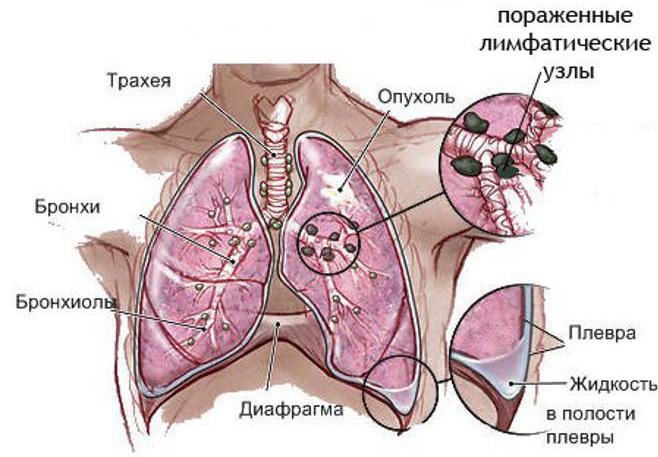
It is also necessary to distinguish four main stages in the development of the oncological process in the lungs:
- Stage I: a single neoplasm does not exceed 30 mm in diameter, there are no metastases, the patient may be disturbed only by a rare cough.
- Stage II: the neoplasm reaches 60 mm, can metastasize to the nearest lymph nodes. The patient at the same time complains of discomfort in the chest, slight shortness of breath, cough. In some cases due to inflammation lymph nodes marked subfebrile fever.
- Stage III: the diameter of the neoplasm exceeds 60 mm, while the germination of the tumor into the lumen of the main bronchus is possible. The patient experiences shortness of breath on exertion, chest pain, cough with bloody sputum.
- Stage IV: carcinoma grows beyond the affected lung, various organs and distant lymph nodes are involved in the pathological process.
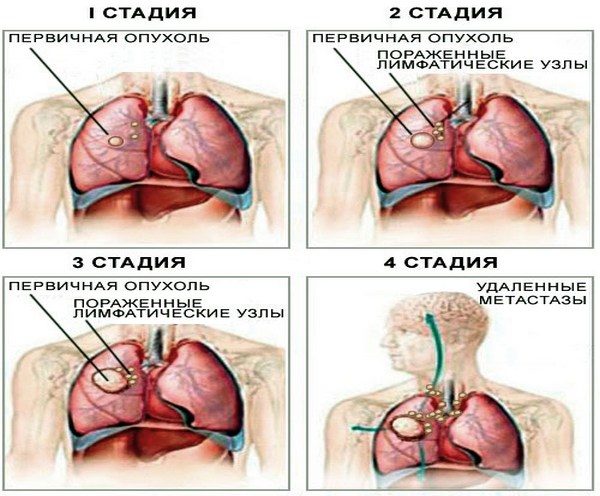
The first symptoms of lung carcinoma
For some period of time, the pathology develops hidden. The patient does not experience any specific symptoms suggestive of a lung tumor. The development of carcinoma can proceed many times faster if there are some provoking factors:
- living in ecologically unfavorable areas;
- work in hazardous industries;
- chemical vapor poisoning;
- smoking;
- genetic predisposition;
- transferred viral and bacterial infections.

Initially, the pathology manifests itself as an inflammatory disease of the respiratory system. In most cases, the patient is misdiagnosed with bronchitis. The patient complains of recurrent dry cough. Also, people in the early stages of lung cancer have the following symptoms:
- fatigue, drowsiness;
- loss of appetite;
- dry skin and mucous membranes;
- slight hyperthermia up to 37.2-37.5;
- hyperhidrosis;
- decreased performance, emotional instability;
- bad breath on exhalation.
Attention! The lung tissue itself does not have sensitive endings. Therefore, with the development of oncological disease, the patient may not experience pain for a sufficiently long period.

Symptoms of lung carcinoma
In the early stages, it is often possible to stop the spread of the tumor by radical resection. However, due to the blurring of symptoms, it is possible to identify pathology at stages I-II in a rather small percentage of cases.
The pronounced characteristic clinical manifestations of the pathology can usually be fixed when the process passes to the stage of metastasis. Manifestations of pathology can be varied and depend on three main factors:
- clinical and anatomical form of carcinoma;
- the presence of metastases in distant organs and lymph nodes;
- disturbances in the functioning of the body caused by paraneoplastic syndromes.
AT pathological anatomy Tumor processes of the lungs are divided into two types of tumors: central and peripheral. Each of them has specific symptoms.
Central carcinoma is characterized by:
- wet debilitating cough;
- sputum discharge with blood inclusions;
- severe shortness of breath;
- hyperthermia, fever and chills.
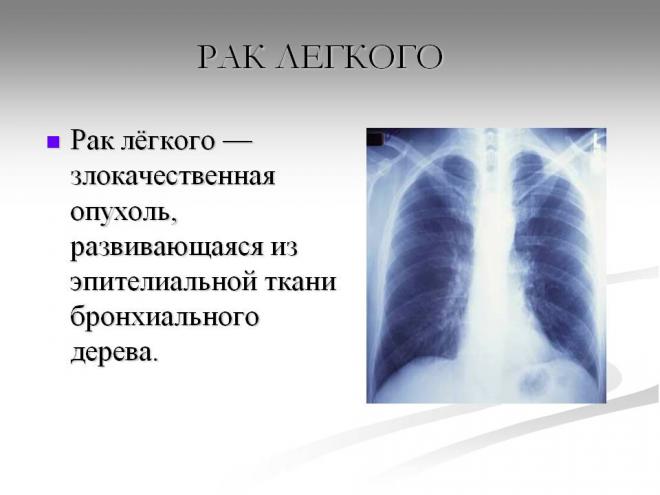
With peripheral oncology, the patient has:
- soreness in the chest;
- dry unproductive cough;
- shortness of breath and wheezing in the chest;
- acute intoxication in case of decay of carcinoma.
Attention! On the initial stages pathology, the symptoms of peripheral and central lung cancer differ, however, as the oncology progresses, the manifestations of the disease become more and more similar.
The earliest symptom of lung carcinoma is a cough. It occurs due to irritation of the nerve endings of the bronchi and the formation of excess sputum. Initially, patients have a dry cough that worsens with exertion. As the neoplasm grows, sputum appears, which is first mucous, and then purulent and bloody.
Shortness of breath occurs at a fairly early stage and appears due to excess mucus in respiratory tract. For the same reason, patients develop stridor - strained wheezing. Percussion heard moist rales and squelching in the lungs. As the tumor grows, if it blocks the lumen of the bronchus, shortness of breath is noted even at rest and rapidly intensifies.
Pain syndrome occurs in the late stages of oncology with the germination of carcinoma in the tissues of the bronchial tree or surrounding tissues of the lungs. Also, discomfort during respiratory movements can disturb the patient due to the addition of secondary infections to the disease.
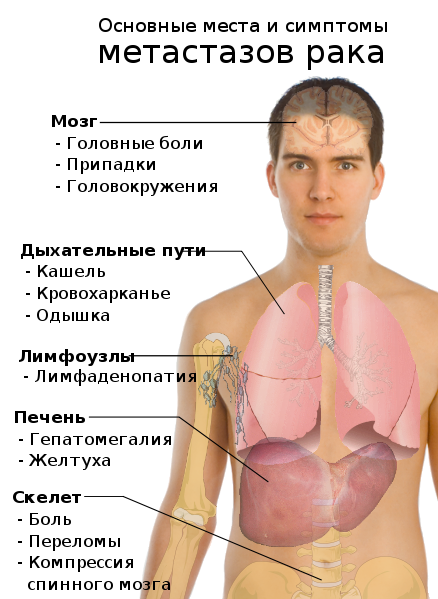
Gradually, the growth of the tumor and the spread of metastases provoke compression of the esophagus, violation of the integrity of the tissue of the ribs, vertebrae and sternum. In this case, the patient has pain in the chest and back, which is of a constant dull character. Difficulties in swallowing are noted, a burning sensation in the esophagus is possible.
Oncology of the lungs is most dangerous because of the rapid growth of metastases in large vessels and the heart. This pathology leads to angina attacks, intense cardiac dyspnea, impaired blood flow in the body. During examination, the patient has arrhythmia, tachycardia, ischemic zones are revealed.
Paraneoplastic syndromes
Paraneoplastic syndrome is a manifestation of a pathological effect on the body malignant neoplasm. It develops as a result of tumor growth and is manifested by various non-specific reactions from organs and systems.
Attention! In most cases, such manifestations of the disease occur in patients at stages III-IV of carcinoma development. However, in children, the elderly, and patients with poor health, paraneoplastic syndrome can also occur at earlier stages of tumor formation.
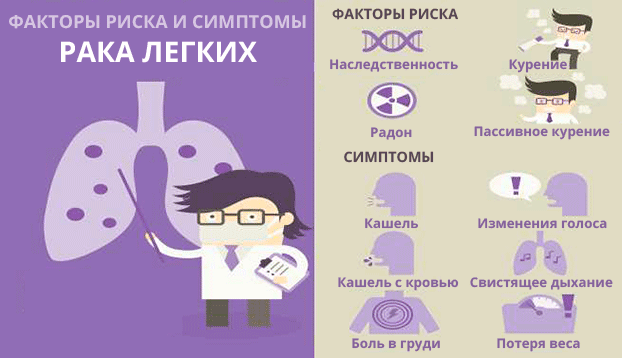
Systemic syndromes
Systemic paraneoplastic syndromes are manifested by a large-scale lesion of the body, in which various organs and systems are affected. The most common symptoms of lung cancer are:
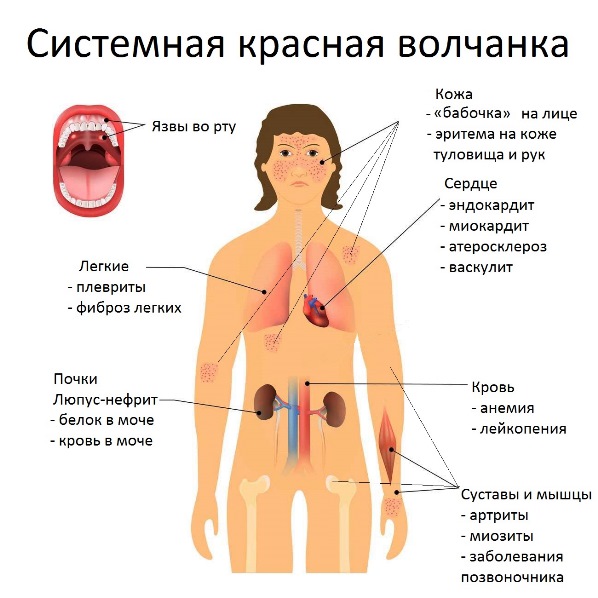
Attention! Systemic syndromes must be carefully and urgently stopped. Otherwise, they can dramatically worsen the patient's condition and lead to his death.
Video - Lung cancer: the first symptoms
Skin syndromes
Skin lesions develop for several reasons. The most common factor provoking the appearance of various pathologies of the epidermis is the toxic effect on the human body of a malignant neoplasm and cytostatic drugs. All this weakens the protective functions of the body and allows various fungi, bacteria and viruses to infect the skin and epithelial integuments of the patient.
In patients with lung carcinoma, the following syndromes are noted:
- hypertrichosis - excessive hair growth throughout the body;
- dermatomyositis - an inflammatory pathology of the connective tissue;
- acanthosis - coarsening of the skin at the site of the lesion;
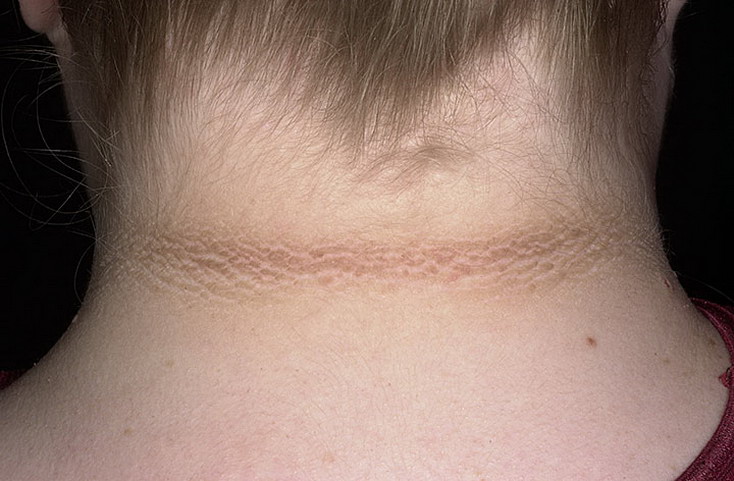
- hypertrophic pulmonary osteoarthropathy - a lesion that leads to deformation of bones and joints;
- vasculitis is a secondary inflammation of blood vessels.
Hematological syndromes
Circulatory disorders in patients with oncological diseases develop quite quickly and can manifest themselves already at stages I-II of the pathology. This is caused by a sharp negative impact of carcinoma on the functioning of the hematopoietic organs and a violation of the full functioning of the lungs, which causes oxygen starvation of all systems of the human body. Patients with lung cancer show a number of pathological symptoms:
- thrombocytopenic purpura - increased bleeding, leading to the appearance of hemorrhages under the skin;
- anemia;
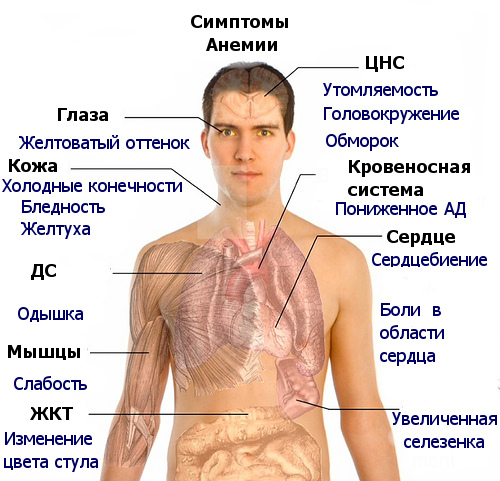
- amyloidosis - a violation of protein metabolism;
- hypercoagulability - an increase in the coagulation function of the blood;
- leukemoid reaction - various changes in the leukocyte formula.
Neurological syndromes
Neurological paraneoplastic syndromes develop in connection with damage to the central or peripheral nervous system. They arise due to a violation of trophism or in connection with the germination of metastases in the spinal cord or brain, which is quite often observed in lung carcinomatosis. Patients have the following disorders:
- peripheral neuropathy - damage to peripheral nerves, leading to impaired mobility;
- myasthenic Lampert-Eaton syndrome - muscle weakness and atrophy;
- necrotizing myelopathy - necrosis of the spinal cord, leading to paralysis;
- cerebral encephalopathy - brain damage;
- vision loss.

Symptoms of stage IV oncology
AT rare cases patients seek medical help only at the stage when oncology turns into carcinomatosis, and the pain becomes unbearable. Symptoms at this stage largely depend on the spread of metastases throughout the body. To date, stage IV lung cancer is extremely difficult to treat, so it is necessary to consult a specialist when the first warning signs appear.
Attention! Carcinomatosis is a multiple metastasis in cancer. With carcinomatosis, any system or the entire body of the patient can be completely affected.
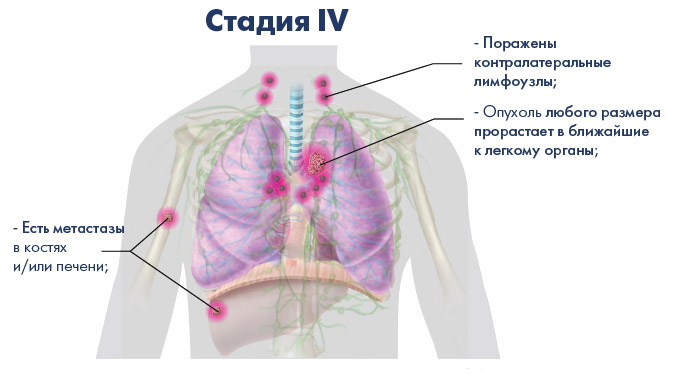
A patient in the late stages of tumor formation develops the following symptoms, indicating a violation of the work of various organs and systems:
- debilitating long-lasting coughing fits;
- sputum with blood, pus and decay products of the lungs;
- apathy, depression;
- constant drowsiness, impaired cognitive function;
- cachexia, weight loss to critical levels: 30-50 kg;
- swallowing disorder, vomiting;
- painful attacks of cephalalgia;
- profuse pulmonary bleeding;
- delirium, impaired consciousness;
- intense persistent pain in the chest;
- respiratory failure, suffocation;
- arrhythmia, violation of the frequency and filling of the pulse.
Lung cancer manifests itself in a variety of ways various symptoms. The most characteristic alarming signals of pathology are a long-lasting cough with sputum, chest pain and wheezing when breathing. When such signs appear, it is necessary to consult a pulmonologist for advice.
Video - Lung Cancer: Causes and Symptoms







